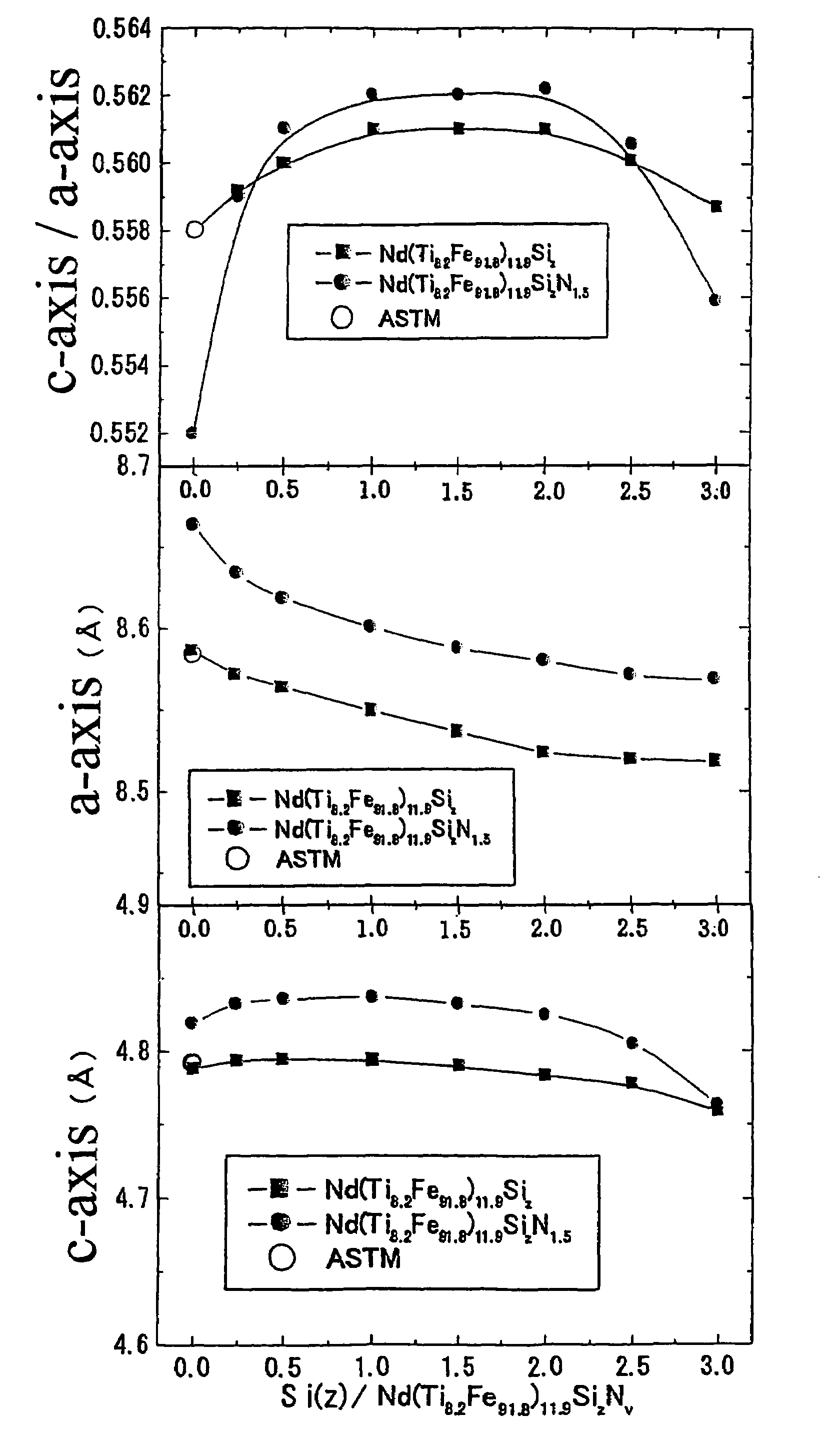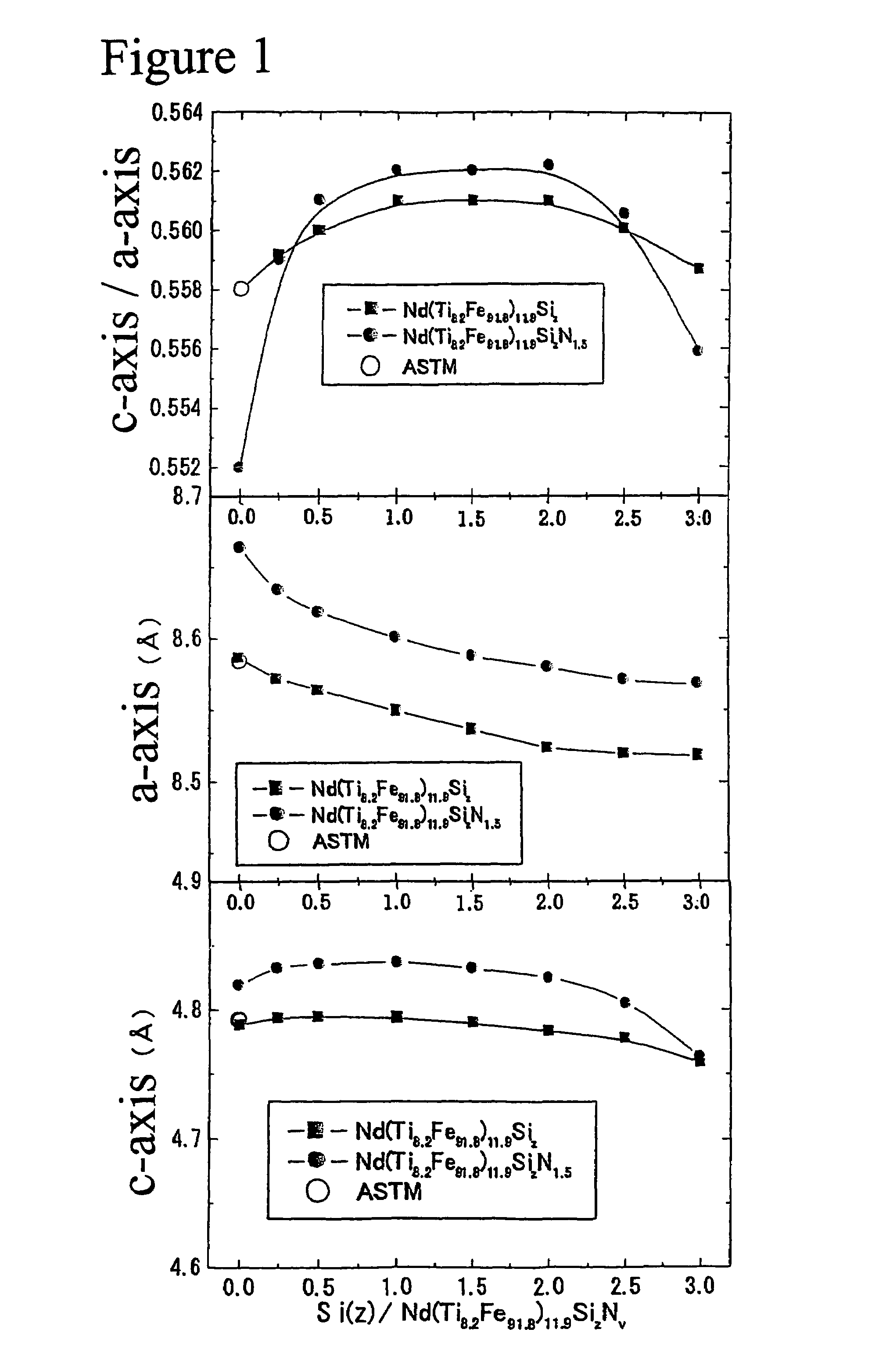Hard magnetic composition, permanent magnet powder, method for permanent magnet powder, and bonded magnet
a technology of hard magnetic composition and permanent magnet powder, which is applied in the direction of magnetic materials, inorganic material magnetism, magnetic bodies, etc., can solve the problems of long time heat treatment at a high temperature, difficult generation of thmnsub>12/sub>phase, etc., and achieve the effect of sufficient magnetic properties
- Summary
- Abstract
- Description
- Claims
- Application Information
AI Technical Summary
Benefits of technology
Problems solved by technology
Method used
Image
Examples
example 1
[0134]The experimental results (experimental examples 1 to 6) supporting the above described reasons for limiting the range of the composition will be described as Example 1. As described above, although the hard magnetic compound of the present invention exhibits the lattice constants different from those of the ThMn12-type compound described in ASTM, the hard magnetic compound concerned exhibits a diffraction pattern in X-ray diffraction identifiable as that of the ThMn12-type compound.
experimental example 1
[0135]At the beginning, description will be made on the experimental results (Experimental Example 1) for the z value (Si content) dependences of the phase state and the magnetic properties.
[0136]High purity Nd, Fe, Ti and Si metals were used as raw materials, and each sample was prepared by means of the arc melting method in an Ar atmosphere in such a way that its alloy composition may be represented by Nd—(Ti8.3Fe91.7)12—Siz. Successively, the alloy was milled with a stamp mill and passed through a sieve with opening of 38 μm, and then subjected to a heat treatment (nitriding) in which the alloy was maintained at 430 to 520° C. for 100 hours in a nitrogen atmosphere. After the heat treatment, each of the samples was subjected to a chemical composition analysis and an identification of the formed phases, and measurements of the saturation magnetization (σs) and the anisotropic magnetic field (HA) The results obtained are shown in FIGS. 2 and 3.
[0137]The identification of the formed...
experimental example 2
[0144]In the same manner as in Experimental Example 1, each sample was prepared in such a way that the composition concerned may be represented by Nd—(Ti8.3Fe91.7)x—Siz—N1.5. The samples obtained each were analyzed for chemical composition, identified for phases, and measured for saturation magnetization (σs) and anisotropic magnetic field (HA). The composition, the magnetic properties and the phases of each of the samples obtained in Experimental Example 2 are shown in FIG. 6. The results of measurement of the saturation magnetization (σs) and the anisotropic magnetic field (HA) for the Samples Nos. 9 to 11 and 17 to 20 are shown in FIGS. 7A and B, respectively. Similarly, the results of the measurement of the saturation magnetization (σs) and the anisotropic magnetic field (HA) for the Samples Nos. 12 to 16, 21 and 22 are shown in FIGS. 8A and B, respectively. It is to be noted that Experimental Example 2 is an experiment carried out for the purpose of investigating the effects of...
PUM
| Property | Measurement | Unit |
|---|---|---|
| mean crystal grain size | aaaaa | aaaaa |
| velocity | aaaaa | aaaaa |
| molar ratios | aaaaa | aaaaa |
Abstract
Description
Claims
Application Information
 Login to View More
Login to View More - R&D
- Intellectual Property
- Life Sciences
- Materials
- Tech Scout
- Unparalleled Data Quality
- Higher Quality Content
- 60% Fewer Hallucinations
Browse by: Latest US Patents, China's latest patents, Technical Efficacy Thesaurus, Application Domain, Technology Topic, Popular Technical Reports.
© 2025 PatSnap. All rights reserved.Legal|Privacy policy|Modern Slavery Act Transparency Statement|Sitemap|About US| Contact US: help@patsnap.com



